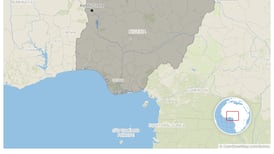For five hours we travelled, heading north from Senegal’s capital, Dakar, towards the Sahara. The villages got smaller and smaller until at last there were none at all.
Three boys from the Fulani tribe crossed our track on a motor-bike and while alone I would have been frightened, my driver immediately saw them as potential guides. We drove in their wake of thin sand through scrub dotted with ancient Baobob trees until we came at last to the gates of the Great Green Wall.
I will never forget that twilight meeting with four Fulani tribal chieftains. The setting sun, a silver disc above the sparse plantation, became a crescent moon and bright stars. We spoke until the chieftains faced Mecca across the empty sands of the Sahel and prayed.
Were they seven feet tall? The tallest one looked it, in his long robe and his high, twisted head-dress of white cloth.
He was the first to speak, greeting me ceremonially on behalf of his people. He was Sadibou Sow, chief of the village of Mbar Toubab. And he had a problem.
“At the beginning,” he said, “the Great Green Wall helped a lot. But for the last two years, it’s not been working.”
The wall
The Great Green Wall is a belt of trees which is planned to stretch across the African continent to prevent the advance of the Sahara Desert. The spread of the desert causes hunger and migration, and disrupts education.
The wall project was formally adopted by the African Union in 2007. If fully planted, it would be the largest living structure the world has seen, some 7,700km long and some nine miles wide. And if the plan works, by 2030 the wall could sequester 100 million tonnes of carbon and create 10 million sustainable jobs.
But all is not well here in Senegal. The guardians of the "parcels" of land have not been paid, says the chief. "Even the women and the old people have not been paid. If we have to move on from here the children will not be able to go to school."
Was this for my benefit? Or for the benefit of Mamadou Banosow, chief of afforestation in the region, who is translating from the Fulani language?
Banosow’s explanation was charming: “Les choses ont prit un certain lenteur,” which means “things have taken on a certain slowness.”
New to the job, and passionate about it, he has shown me the first “parcel” of land planted with acacia trees in Senegal as part of the Great Green Wall, with planting continuing annually.
The Senegalese government’s plan is to plant 10,000 hectares every year, comprising about 300,000 saplings, as part of the Great Green Wall. The aim is to have 400 living trees on every hectare of dry land. “Every year,” he says, “we separate the living from the dead.”
In this part of the Senegalese Sahel, just 80km from the southern Sahara, there is usually 100-150mm of rain every year. Even 200mm is now rare. In Ireland, on average we get 1,500 mm.
The temperature seems to be rising 1.5 times faster in the Sahel than the global average and while some modelling shows the eastern Sahel getting more rain in the future, the western Sahel is getting less and less. “The trees are smaller and smaller as it gets more and more dry,” says Banasow.
Twigs
The trees planted last year are little more than twigs but he presents them with fatherly pride.
Basic supports such as rainwater harvesters would help. He attributes the delay in the provision of resources to the process of bringing the Great Green Wall under the auspices of the Senegalese Agency of Afforestation, a move he welcomes. He intones with reverence the name of the new director general of the Great Green Wall, Ali al Haidar, who has been in the job about six months.

Can Haidar rebuild confidence in the wall in Senegal? He is inspiring. A former minister for the environment who is described as a “militant ecologist”, he was responsible for the massive replanting of the mangrove swamps in Casamance, southern Senegal, which is one of the largest reforestation efforts undertaken anywhere in the world.
Now, from his new office in Senegal’s capital, Dakar, he responds to my question about the delay in paying the Mbar Toubab villagers for their afforestation work by asking a question: Why should people be paid for planting trees that benefit them?
It’s a question that goes to the very roots of this project and of aid programmes generally. It has been noted by the UN that to date African nations have dedicated relatively few of their own resources to the project, leaving the pitch open for international funders.
“We will have to leave behind the idea that people are planting for other people”, he explains. “We need to plant trees that are useful to people in themselves.”
Without community ownership of the project, the trees will not be respected and risk being cut down. The grass they shelter will be eaten by wandering animals, as has happened on the first parcel in Mbar Toubab, probably due to discontent when the day-rate payments dried up.
As to which trees to plant, Haidar agrees they can plant only trees that don’t need much water, such as Balanites (the “date of the desert”), fruit-bearing jujubes, the prosopsis shrub, the Senegalese and Arnica Acacia trees and the iconic Baobabs, some of which are still standing after 2,500 years.
He has far-reaching plans, however, to use irrigation techniques such as the digging of irrigational channels across the land to improve water retention, coupled with walls around individual plots, as has been achieved in Burkina Faso. He also supports new plans to bring water from the Senegal River into the Sahel.
He talks of planting forage for animals but also fruit trees and date palms, which are grown in neighbouring Mauritania.
For him it's not a question of choosing between direct plantation and restricting animal movements to allow self-seeding on "set aside" land, known as "farmer-led natural regeneration", which has been very successful in Burkina Faso and Niger. "We will do everything," he says. "We want to be an example for Africa. " He won't be able to do it on his own.
The value of trees
What seems crucial now – in Ireland, the most treeless country in Europe, as much as in Senegal – is basic education on the essential value of trees to humans: their ability to store carbon, to offer shelter, to offer food, to hold water in the ground, to host birds, animals, insects, plants, to replenish the Earth.
In another part of Mbar Toubab, a more successful “parcel” is managed on contract instead of on daily labouring rates by the kind of man who could lead this education. Amadour Isasow planted the first Great Green Wall trees in Senegal.

He has dug long irrigation canals across the land, with acacias planted halfway in so that they won’t be drowned during the short rainy season, and says they must be planted intensively “from first to last rain”.
Hard as it is, he enjoys the work he now shares with his adult son, both living in a tiny enclosure of straw huts beside the “parcel”.
“I love nature,” he says. “All my life I have struggled to maintain the trees here.” Once, he says, there were hyenas, gazelles, warthogs, even lions in the area. “All, all is gone.”
Among the many educational initiatives helped by the Great Green Wall in Senegal is the small school in Mbar Toubab, which sits between villages in the middle of nowhere. Fulani children walk as far as 13km to school every day.
Not only was solar electrification of the school and the teachers’ accommodation paid for in part by the villagers’ harvest from their forested “parcel”, but the wall administration also initially partnered with the school in running their school garden.
Here, a dedicated team of teachers and pupils have created an oasis of lemons, bananas, melon, butternut squash, mint, cassava, potatoes, lettuce, peppers, mandarins, manioc, ocra, tomatoes, onions, mangoes and much more.
Because of the garden, says headmaster Amadou Aboubakrine, you no longer see children cutting down trees.
The wider aims of the wall project are obvious in this school. Going to school anchors Fulani children in one place and encourages their parents not to move on with their herds of animals. Over-grazing is the biggest single cause of desertification in the Sahel. The new climate can’t support the current numbers of people and animals unless they stop practising “transhumance” (the seasonal movement of livestock) and give designated areas of land a chance to recover and reseed.
Facial tattoos
Newly-graduated teacher Mariam Niang describes taking this job in the middle of nowhere as a chance to serve her country. She says she is trying to further “the cause of women” by interceding with Fulani parents against the marriage of girls as young as 12 and against facial tattoos at puberty.
Senegal has outlawed female genital mutilation and the rate is reckoned low among the people of this Sahelian region.
Part of the original Great Green Wall idea in the village of Mbar Tourbab was to employ the women in a market garden, meaning they made some cash of their own in a social setting. The garden is now deserted, and Tasmanian Devils have dug holes in the paths as they search for frogs.
The Great Green Wall didn’t provide the necessities for planting this year, and the women left.
The manager, who is on contract and still working on his own, says he hasn’t been paid in two months.
“Les choses,” explains the GGW ranger once again, “ont prit un certain lenteur.” But this is no time for “slowness”.
Moussa Sy, a tribal chief in the nearby village of Bobaral, who has studied and worked in the desert regions of north Africa, calls the people of the Sahel “the first line of defence against climate change”.
In the village of his childhood, he says, there was plenty of rain, thick trees, many varieties of grass and lots of milk. There were ostriches and gazelles.
Sitting in the shade of his straw hut, with the village children clambering over him, he gestures towards the sand which stretches to the horizon.
“There wasn’t this… this empty space. The kids don’t know how it was. The difficulty is for us. We remember how it was...”
He warns now: "The desert is coming towards us. Climate change explains this heat we're experiencing. Everyone needs to think about this, even you up there in your paradise in Ireland. The Great Green Wall is a project for our future and everyone must give it their energy, their knowledge, their money."
What will happen, he asks, if he and his communities are “hunted” out of the Sahel?
To keep them there he shares ideas that are gaining ground here, of “farmer-led regeneration”, pilot farms made up of tillage, grazing and set-aside, criss-crossed with irrigation canals to stop nomadism and keep children in school.
He fears, however, that the hierarchy of priorities in places of power further north may not serve the needs of his people. “The taste today is for exploitation. The young want cars, nice houses and to practise the kind of intensive agriculture that wrecks the land.”
More than anything else, says Moussa Sy, we need a new relationship with trees. “What we need is a development in our consciousness,” he says. “Then the Great Green Wall can be built very quickly.”
This assignment was supported by the Simon Cumbers Media Fund











